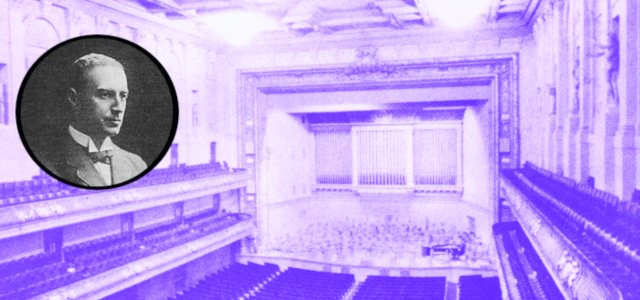Without a doubt, Wallace Clement Sabine’s work on architectural acoustics generally is recognized as the first step of the modern era in the development of the beginning of measurement and correction of acoustic conditions in enclosed spaces. Prior to Sabine’s investigations, architectural acoustics was a bafflement that, over the ages, had entrapped any number of architects.
True, in the pre-Christian period, Roman architect Marcus Vitruvius Pollio alluded to a number of ways to minimize echoes and conflicting sound transmissions in the theater.1 However, given the era in which Vitruvius wrote, there was no means to either measure or quantify the effects of poor acoustical transmission within a given space. So, there the subject rested for some 18 centuries until modern physics and subsequent acoustical research could catch up with these observed phenomena.
“Why is it that when the orchestra of a theater is spread with straw, the chorus makes less sound?” -Aristotle
Little progress occurred in the acoustical sciences between the time of Lucretius (94-55BC)—who addressed the subject of reverberation (although not calling it by that name), when he wrote, “One voice…disperses suddenly into many voices…some dashed upon solid places and then thrown back….Therefore the whole place is filled with voices [and] all around boils and stirs with sound.…”—up through the time of T. Roger Smith, a British architect who raised much the same issues in his 1864 The Acoustics of Public Buildings.
Indeed, two millennia after Aristotle’s Problemata raised the question, “Why is it that when the orchestra of a theater is spread with straw, the chorus makes less sound?”2, T.R. Smith was to restate the Aristotelian rhetoric by commenting, “When there is too much resonance in a room, carpets or curtains may be advantageously employed to lessen it.” Consequently, our pre-Sabine knowledge of acoustics had not advanced much beyond the advice provided in Exodus XXVI, wherein the horizontal length of goat-hair curtains specified for the tabernacle ensured that the curtains would hang in generous, sound-absorbing folds.
Sabine—the Early Years
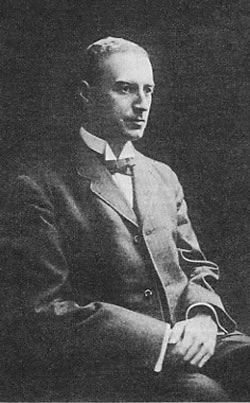
Until W.C. Sabine’s contributions to the understanding of sound transmission (which extended from 1898 until his untimely death at the age of 51 in 1919), the acoustical success or failure of any given structure was by and large happenstance, and dependent on a large degree of good or bad luck on the part of the architectural designer.
Sabine, born in Richwood OH in 1868, was graduated from Ohio State University with a BA in physics in 1886 and continued his graduate studies at Harvard University. It was during his all-too-short, lifelong association with Harvard that he generated the volume of his studies and papers concerning sound propagation principles. In his initial work in Harvard’s physics department, Sabine concentrated his efforts on optics and electricity; indeed, there would have been scant opportunity to pursue a course of study in acoustics because no such course of study yet existed. In his later years, after being awarded honorary doctorates by Brown University (1907) and Harvard (1914), he remarked, “When the proper time came for me to [pursue my PhD], I should have had to been my own examiner.”3
Thus, the young Sabine was approached by then Harvard president Charles William Eliot to “do something” in an effort to correct the acoustical difficulties in the newly constructed lecture room at the Fogg Art Museum (which was completed in 1895). Acoustical conditions had made the space almost totally unusable. The conditions and/or arrangements that prompted Eliot to seek out Sabine have been lost from the record, but suffice to say, Sabine (perhaps begrudgingly) accepted the assignment and turned diligently toward defining the problems.
The young Sabine was approached by then Harvard president Charles William Eliot to “do something” in an effort to correct the acoustical difficulties in the newly constructed lecture room at the Fogg Art Museum.
He attempted to effect the necessary corrections that would make this venue an acoustically usable space. Armed with nothing more than a few organ pipes, a stopwatch and a well-disciplined sense of hearing, he embarked upon the challenge of quantifying what constituted offending acoustic transmission. Bear in mind that, at the time of his initial investigations, the telephone was still a “new-fangled gadget,” the practical application of electronic amplification was not yet available and the means to measure acoustical responses were totally lacking. Adding to the problem was almost non-existent published references on the subject of acoustics. Hence, Sabine was faced with having to plow virtually virgin soil to complete his quest.
Quantifying Reverberation
Sabine’s initial assignment to “do something” about the poor state of the acoustics in Fogg Hall quickly took on a broader meaning that he interpreted to be development of acoustical measurements that could be applied in a consistent and repeatable manner. He was to note: “These problems are necessarily complex, and each room presents many conditions, each of which contributes to the result in a greater or less degree according to circumstances. To take justly into account these varied conditions, the solution of the problem should be quantitative, not merely qualitative; and to reach its highest usefulness it should be such that its application can precede, not follow, the construction of the building”4 [emphasis added].
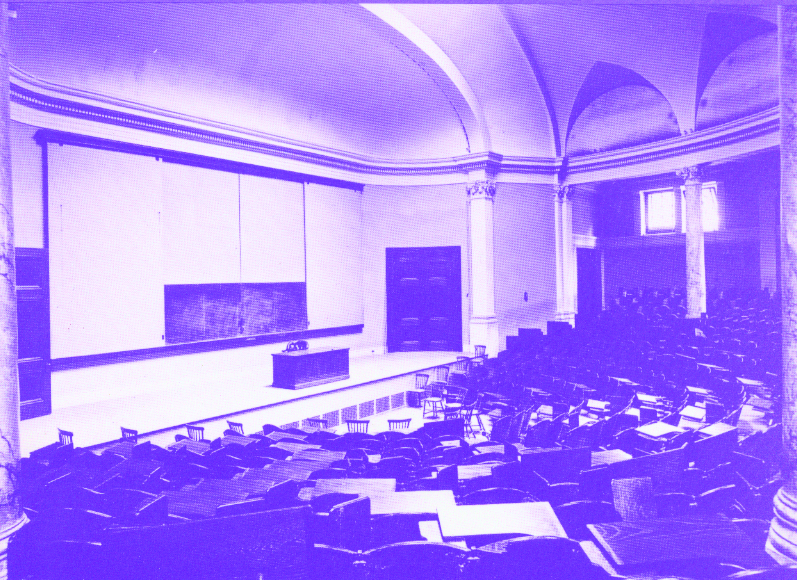
With that self-imposed dictate in mind, Sabine set about gathering data from the limited resources available. This, of course, meant painstaking, late-night investigations at the offending Fogg Hall; comparisons to similar measurements made at the nearby, reputedly more acoustically pleasing Sanders Theater; and comparative examination of the collected data in a constant-temperature room in the sub-basement of the Jefferson Physical Laboratory—a room that, in essence, became Sabine’s reverberation chamber.
These measurements were made not without considerable difficulty. In the year 2001, we might not fully appreciate that these experiments were not carried out by simply unplugging a host of electronic equipment and transporting it to the other locations. Rather, the mechanical apparatus required dismantling and reassembly for each subsequent set of tests in each of the different locations. Given these conditions, it is no wonder that Sabine’s experiments stretched out over two years.
As Fredrick V. Hunt relates,5 Sabine was engrossed in reviewing his data on a quiet Saturday evening on October 29, 1898, comparing the duration of sustainable sound as it applied to the absence versus the introduction of seat cushions laboriously brought over from Sanders Theater to the Fogg Hall location. It is claimed that he triumphantly shouted from his study to his mother in the adjacent room: “Mother, it’s a hyperbola!” The essential formula for the determination of reverberation constant was thus determined to be:
T = 0.161 V/A
Where “T” is the duration of the residual sound to decay below the audible intensity, “V” is the room volume in cubic meters and “A” is the total absorption in square meters.
At that point, the science of architectural acoustics had its beginning. Sabine had, in a rudimentary fashion, determined that there was a basic relationship between the volume of a space and the total amount of sound-absorption materials placed within such a space, which, in turn, would determine the decay rate of the sound within such a space.
The acoustical deficiencies at Fogg Hall were corrected by installing quantities of felt in sufficient layers.
Obviously, much more work was required before the reverberation equation could be successfully and consistently employed. Nevertheless, the acoustical deficiencies at Fogg Hall were corrected by installing quantities of felt in sufficient layers, bringing the reverberation characteristics of the hall into measurable conformance with the observed good acoustics experienced at Sanders Theater.
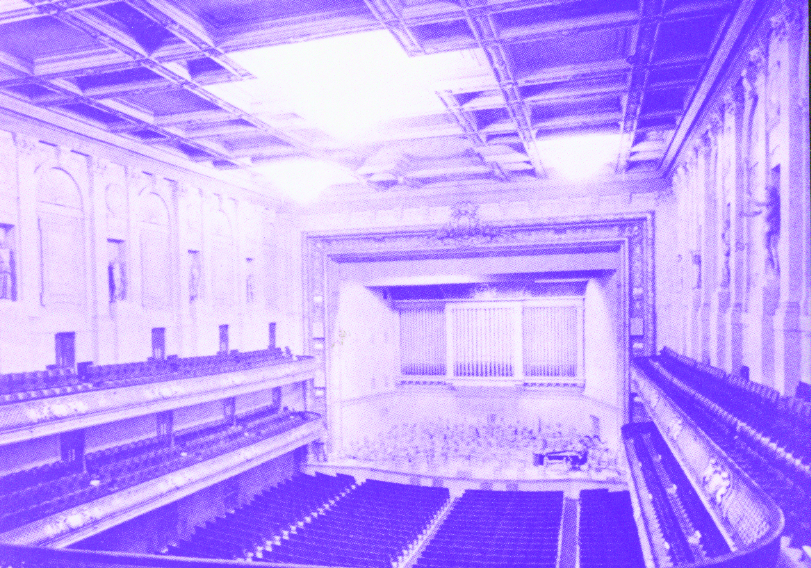
Sabine’s successful “taming” of Fogg Hall subsequently earned him a commission to design the acoustical properties of the then-under-development Boston Music Hall (now known as Symphony Hall), which is still considered one of the world’s finest halls for the presentation of symphonic music. Indeed, Leo Beranek, in his tome, Concert and Opera Halls and How They Sound, touts even to this day the superb Boston Symphony Hall as an example of how acoustical excellence can be achieved in an enclosed space.6
Even more significant was the fact that Sabine designed the acoustical properties of Boston’s Symphony Hall before the fact; that is, his calculations for acoustical reflections were not after-the-fact corrective measures, but an inherent part of the initial design. Truly, Sabine had brought to the scientific world a degree of acoustical design on par with the other mechanical, structural and electrical elements that are used to calculate the particulars of any modern structure.
Search for More Knowledge
Sabine thence began researching additional ramifications with respect to the propagations of sound. On the subject of loudness, remembering that this was in the pre-audio-amplification era, Sabine noted: “The problem of calculating the loudness at different parts of such an auditorium is, obviously, complex, but it is perfectly determinate, and as soon as the reflecting and absorbing power of the audience and of the various wall surfaces are known, it can be solved approximately.”
Preceding others by some six decades, Sabine arrived at the basic problem of audio phase relationships. He also anteceded the recognition of “comb-filtering” in his comments relative to side interference.
Again, preceding others by some six decades, Sabine arrived at the basic problem of audio phase relationships when he wrote: “Should one path [of audio transmission be shorter than the other], rarefaction by one and condensation by the other may arrive at the same time, and at this point there will be comparative silence. The whole room may be mapped out into regions in which the sound is loud and regions in which it is feeble.”
He also anteceded the recognition of “comb-filtering” in his comments relative to side interference when he observed that “It may be a most serious matter when two persons side by side can talk together with but little comfort, most of the difficulty being caused by the interference of sound.”
With these basic tenets in mind, Sabine began exploring the characteristics of various absorptive materials as they might relate to particular frequencies. Thus, he recognized that absorption of materials was frequency-dependent and required specific absorptive employment relative to the offending characteristics of the transmitted sound. Again, using nothing more sophisticated in the way of test equipment than a rank of organ pipes and a chronometer, Sabine determined that the rate of decay was a function of the produced tone (frequency) and the interrelationship (absorptive characteristics) of various materials. This interest would later result in the construction of the Wallace Clement Sabine Testing Laboratories at Riverbank Labs in Geneva IL. (More on this subject will follow below.)
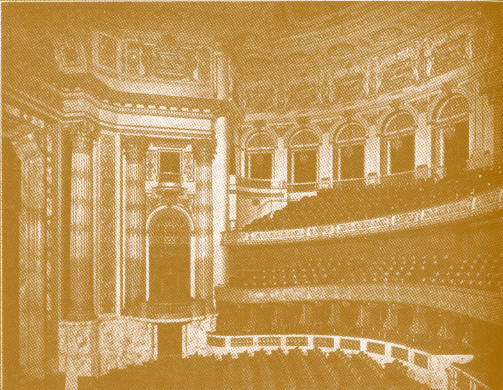
Sabine, writing for The American Architect and The Engineering Record in 1900, expanded on his thesis related to acoustical reflections. In those published proceedings, Sabine introduced the term “reverberation” when he defined the subject of acoustical confusion, echoes and extraneous sound as being—in considerable measure—attributable to reverberation within any given space. That his studies failed to account for the positive attributes of early reflections can certainly be forgiven, considering his lack of access to what we would now consider ”rudimentary” instrumentation.
His consideration was the development of spaces that would lend themselves to articulate speech transmissions. With no intention to subtract from Sabine’s success at the Boston Music Hall, that design may be considered an apparition, and an apparent successful exercise that transformed the space into a symphonic hall from basic principles that applied primarily to speech-reinforcement considerations. Yet, let us not knock success regardless of how achieved.
Reverberations and Echoes
Sabine also early on recognized the distinction between reverberation and echoes, and wrote: “In the general case of reverberation we are only concerned with the rate of decay of the sound. In the special case of the echo we are concerned not merely with its intensity, but with the interval of time elapsing between the initial sound and the moment it reaches the observer.”
Consequently, he had correctly identified the subtle difference between the normal decay rate of sound as a function of absorption (reverberation) and the annoying introduction of echoes produced by “slap-back” from offending surfaces.7
Sabine undertook an examination of how various absorbing materials compared to an open window. This resulted in the now well-understood principle that one square meter of 100% absorbing material has an absorption factor of one square meter of open window.
In a further effort to quantify the value of absorption, Sabine undertook an examination of how various absorbing materials compared to an open window that is, in essence, a means whereby sound energy can escape the property and thus represent a 100% transfer of acoustical energy from the structure or the equivalent of a material with 100% absorption characteristic (frequency dependence aside).
A ‘Sabin’
This resulted in the now well-understood principle that one square meter of 100% absorbing material has an absorption factor of one square meter of open window. In honor of W.C. Sabine, the unit of absorption is termed one “sabin”8 or “metric sabin.” One sabin is the absorption of one square foot of open window, and one metric sabin is the absorption represented by one square meter of open window.
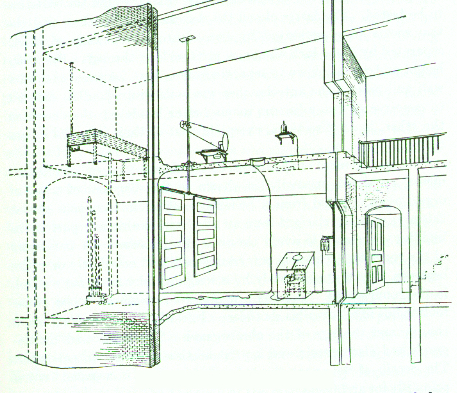
Understandably, the initial work by Sabine has undergone considerable scrutiny and refinement since he first introduced his concepts in the early 1900s, and many distinguished acousticians have lent their efforts to further defining the terms for acoustical reverberation and the subsequent effects within an enclosed space. However, it is to W.C. Sabine that we owe the initialization of the processes that define our current understanding of acoustic transmission within a given space.
Lest one assume that Wallace Sabine’s contributions to acoustics were narrow in scope and limited in focus, let us report that he became very much in demand as an acoustical consultant for many outstanding structures constructed during his active years, and lent his professional opinions and findings in a host of papers both describing his activities and probing how he and his colleagues could further the advancement of acoustical science.
The Riverbank Years
Under what some might consider rather bizarre circumstances, Sabine became associated with Colonel George Fabyan, a somewhat eccentric gentleman from Geneva IL whose interests were broad. Fabyan engaged a diverse group of researchers who lent their efforts toward reconstruction of various Rosicrucian subjects of interest such as acoustical levitation and the pursuit of deciphering the works of William Shakespeare with the intent to prove that Sir Francis Bacon was the actual author of those works, among other notable but obscure subjects.9
Sabine agreed to join the Fabyan research team in exchange for an agreement that Colonel Fabyan would construct (at Fabyan’s expense) an acoustical research laboratory that would allow Sabine to continue his experiments in the relative quiet of Fabyan’s Riverbank Estate in the Illinois countryside and away from the noise and tribulations encountered in Cambridge MA.
Sabine then set to work designing an acoustical testing site for further work on determining the acoustical absorption characteristics of a variety of materials. Unique in nature, the facility, which still stands, boasts extensive use of floating walls and floors of massive proportions. The glass entryway is still etched to indicate that it is The Wallace Clement Sabine Acoustical Laboratory. After Fabyan’s death in 1937, the facility passed through a number of corporate ownerships and is now under the operation of the ITT research institute, which continues to use it as a testing site for acoustical materials.
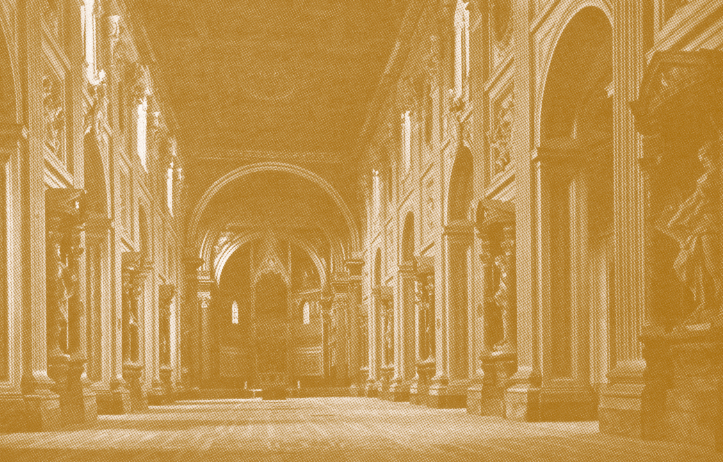
World War I interrupted Fabyan and Sabine’s investigations of acoustical matters. Their attention was drawn to war-related activities that included cryptography, trench-warfare techniques and aerial photography. Sabine, with his earlier experience in the physics of optics, was pressed into service to pursue the advancement of aerial photography, and served distinguishably on the French/German front in perfecting the technique of aerial reconnaissance.
Wallace Sabine’s works have stood the test of time and are still greatly relied upon in the design of modern structures.
Despite Sabine’s preoccupation with other matters, construction on the Riverbank Acoustical Labs continued. Upon the cessation of hostilities in 1918, Sabine returned to Riverbank and commenced calibrating the labs and the associated instrumentation.
Owing to his disregard for personal health matters, a long-ignored liver ailment sent Wallace Sabine to an early grave in 1919.
Other Sabines
Certainly, Wallace Clement Sabine’s contributions come to the forefront; but we would be remiss in neglecting the contributions of his successors. After Sabine’s death, Colonel Fabyan sought out a suitable replacement to carry on his work, and again turned to Harvard. A candidate was quickly identified in Paul Sabine, a distant cousin of Wallace, who shared a common great grandfather. The Sabine name proved to be both a boon and an albatross as Paul sought to achieve his own eminence in the shadow of his distinguished and acclaimed forbearer Wallace.
Paul was a dedicated and distinguished acoustician in his own right and contributed mightily to the efforts of Riverbank Labs until his retirement in the 1950s. At that time, he tossed the Sabine mantle to his son, Hale, who then assumed the directorship at Riverbank, a relationship that continued through 1961.
Conclusion
Thus, we acknowledge and honor that individual whose pioneering efforts provided us with a greater insight into the characteristics of sound and the attendant transmission and blocking of unwanted sound within an architectural structure.
Wallace Sabine’s works have stood the test of time and are still greatly relied upon in the design of modern structures. The acoustical consulting fraternity and the audio industry as a whole must be appreciative of Sabine’s work; otherwise, we might still be hanging cubits of goat-hair rugs in a subjective fashion to achieve acceptable acoustical responses.
References
1 Hunt, Frederick Vinton, Origins in Acoustics, Acoustical Society of America, Woodbury NY, 1992: ISBN 0-300-02220-4
2 No, the reference did not advocate burying the musicians in straw but in this sense: “Orchestra” in the Greek meaning refers to the flat space extending off the floor of the amphitheater in front of the stage.
3 Hunt, Fredrick V, Introduction to the Dover Edition of the Collected Papers on Acoustics, 1964 (originally published by Harvard University Press, 1922), republished by Peninsula Publishing, Los Altos CA. ISBN 0-932146-60-0
4 Sabine, Wallace Clement, Collected Papers on Acoustics (Theodore Lyman, Editor), Harvard University Press, Cambridge MA: 1922
5 Hunt, ibid
6 Beranek, Leo, Concert and Opera Halls, How They Sound, Acoustical Society of America, Woodbury NY: ISBN 1-56396-530-5
7 For a more detailed mathematical and graphical analysis of these phenomena, the reader is referred to Sabine’s papers as referenced in footnote 4.
8 In one of those quirks of history, for whatever reason, Sabine’s great grandfather chose to adopt the French spelling in lieu of their more Germanic family name. Hence, the measurement term came to be expressed as “sabin” instead of Sabine.
9 For a fascinating insight into this aspect of Sabine’s career, please refer to The Sabines at Riverbank, by John W. Kopec, published by the Acoustical Society of America, Peninsula Publishing, Los Altos CA. ISBN 0-932146-61-9.
This article was originally published in the October 2001 issue of Sound & Communications.
Click here for more of Sound & Communications’ “Industry Pioneers” series.
